Solana DePIN report: From "mining" to "map", how can ordinary people make money while lying down?

転載元: panewslab
05/01/2025·21D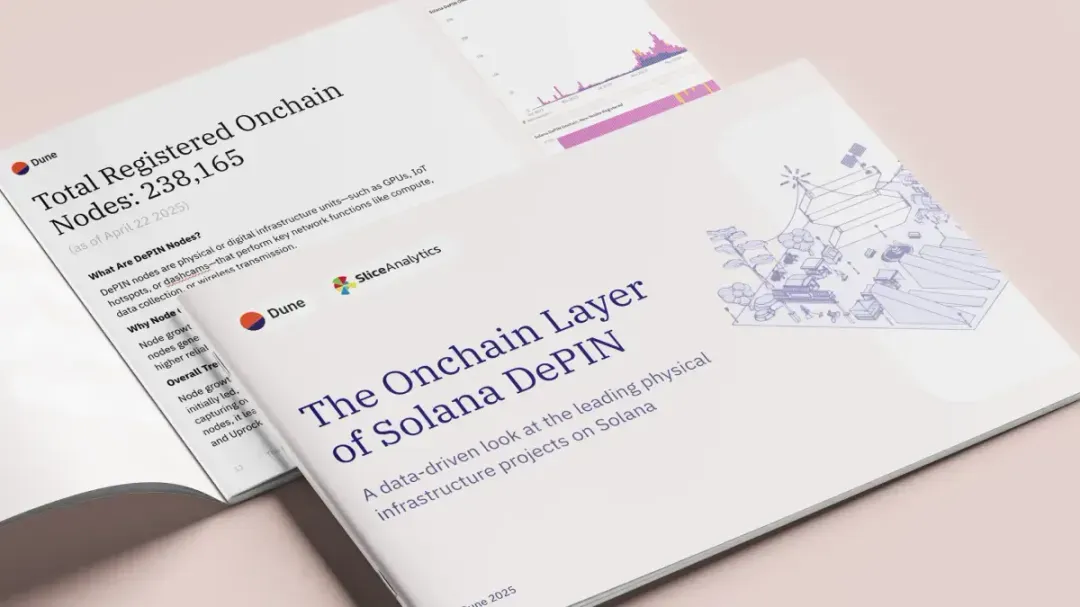
Original text: Dune, Slice Analytics
Compiled by: Yuliya, PANews
Among the many innovations in the blockchain industry, the decentralized physical infrastructure network (DePIN) is rapidly rising and becoming a bridge for real-world assets to be chained. Whether it is shared GPU, telecommunications network, or street map collection, DePIN is reshaping the construction and operation methods of infrastructure through encryption incentive mechanisms. Solana is gradually becoming the core platform for this trend, and its high-performance network provides an ideal expansion soil for DePIN projects.
Based on the latest research report jointly released by Dune and Slice Analytics, this article conducts in-depth analysis on the development status, market performance and on-chain data of multiple core DePIN projects on Solana. The report data as of April 22, 2025 provides us with a clear picture of this emerging ecosystem and reveals the real and verifiable growth trajectory behind it.
DePIN concept and Solana advantages
What is DePIN?
Decentralized Physical Infrastructure Network (DePIN) is an innovative model that utilizes cryptocurrency incentives to launch and operate real-world infrastructure. These projects usually target markets with strong demand but inefficient supply, revitalizing idle resources (such as idle GPUs, wireless bandwidth, etc.). Unlike traditional infrastructure models dominated by large enterprises, DePIN allocates ownership to individuals, thereby increasing efficiency, increasing resilience and enhancing accessibility.
Why choose Solana?
With its high throughput, low transaction fees and composable infrastructure, Solana has become the ideal platform for transparent expansion of DePIN applications. Its thriving ecosystem and strong developer community are making it the center of this emerging field. As Amira Valliani, head of DePIN of the Solana Foundation, said:
" DePIN is about to reach escape speed. This innovative business model has proven its ability to scale physical infrastructure networks faster and cheaper in a community-driven way - and it all happens on Solana. The world's largest DePIN project was chosen to be built on Solana because of its high performance and active capital markets and remains for its thriving community ecosystem."
DePIN Market Overview
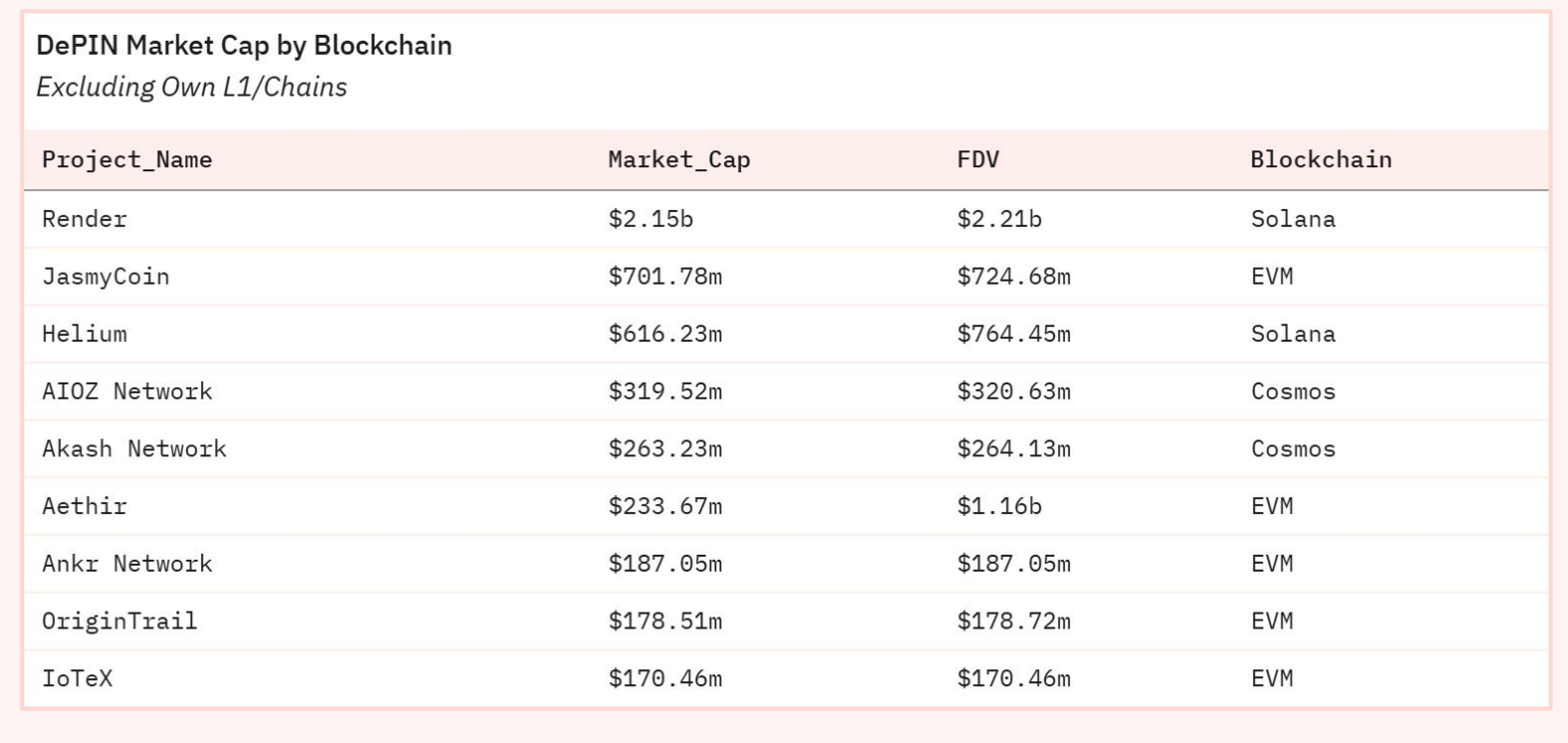
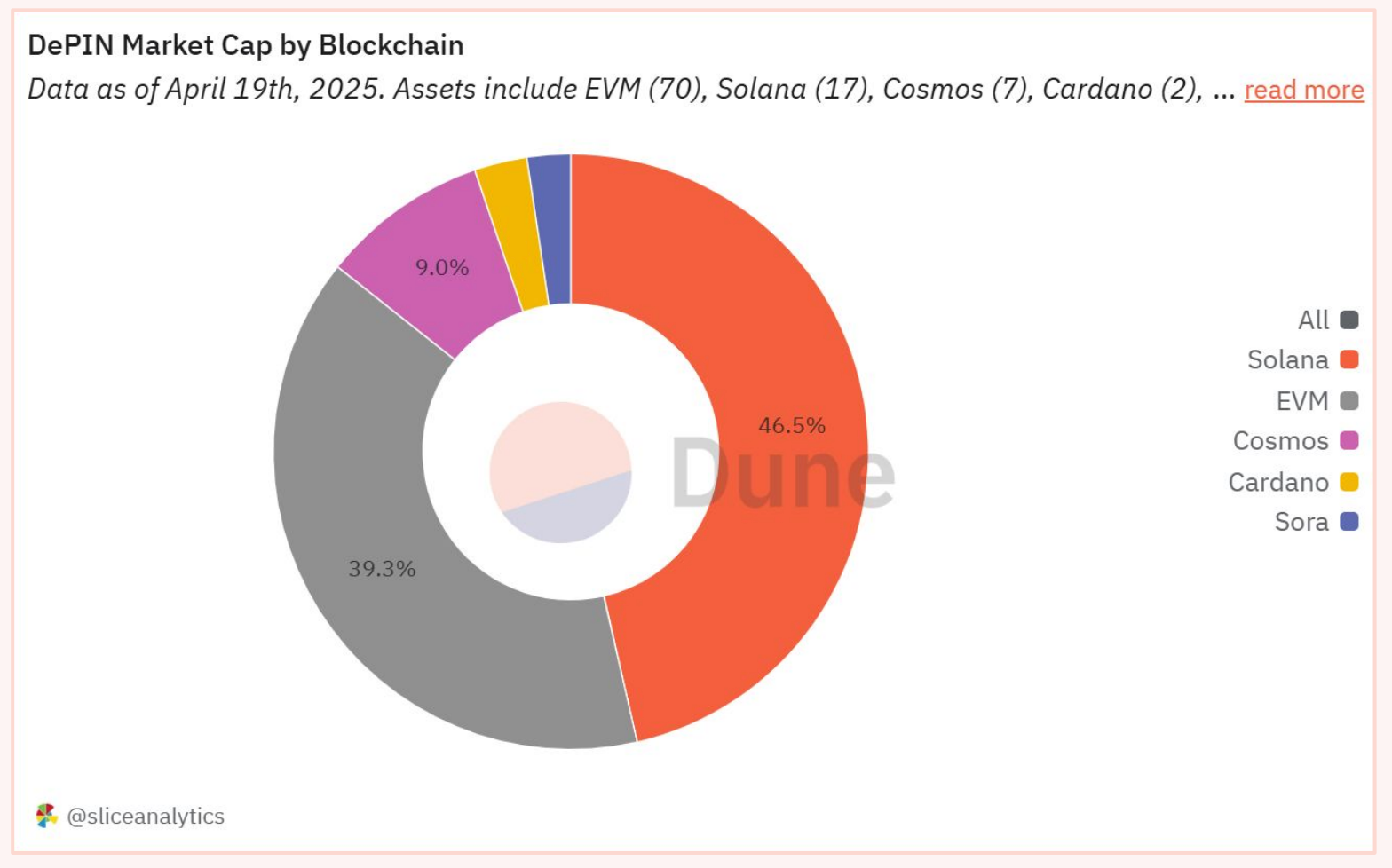
As of April 2025, the total chain market value of DePIN projects worldwide (excluding independent projects L1/chain) has reached US$7.1 billion, of which the total market value of DePIN projects on Solana is US$3.25 billion, leading other blockchain platforms such as EVM (US$2.84 billion) and Cosmos (US$652.5 million), Cardano (US$195.2 million) and Sora (US$160.1 million).
By average market cap for each project, Solana leads again with $191.3 million, with Cardano ($97.6 million), Cosmos ($93.2 million), Sora ($80.1 million) and EVM ($40.6 million) following.
Project category distribution

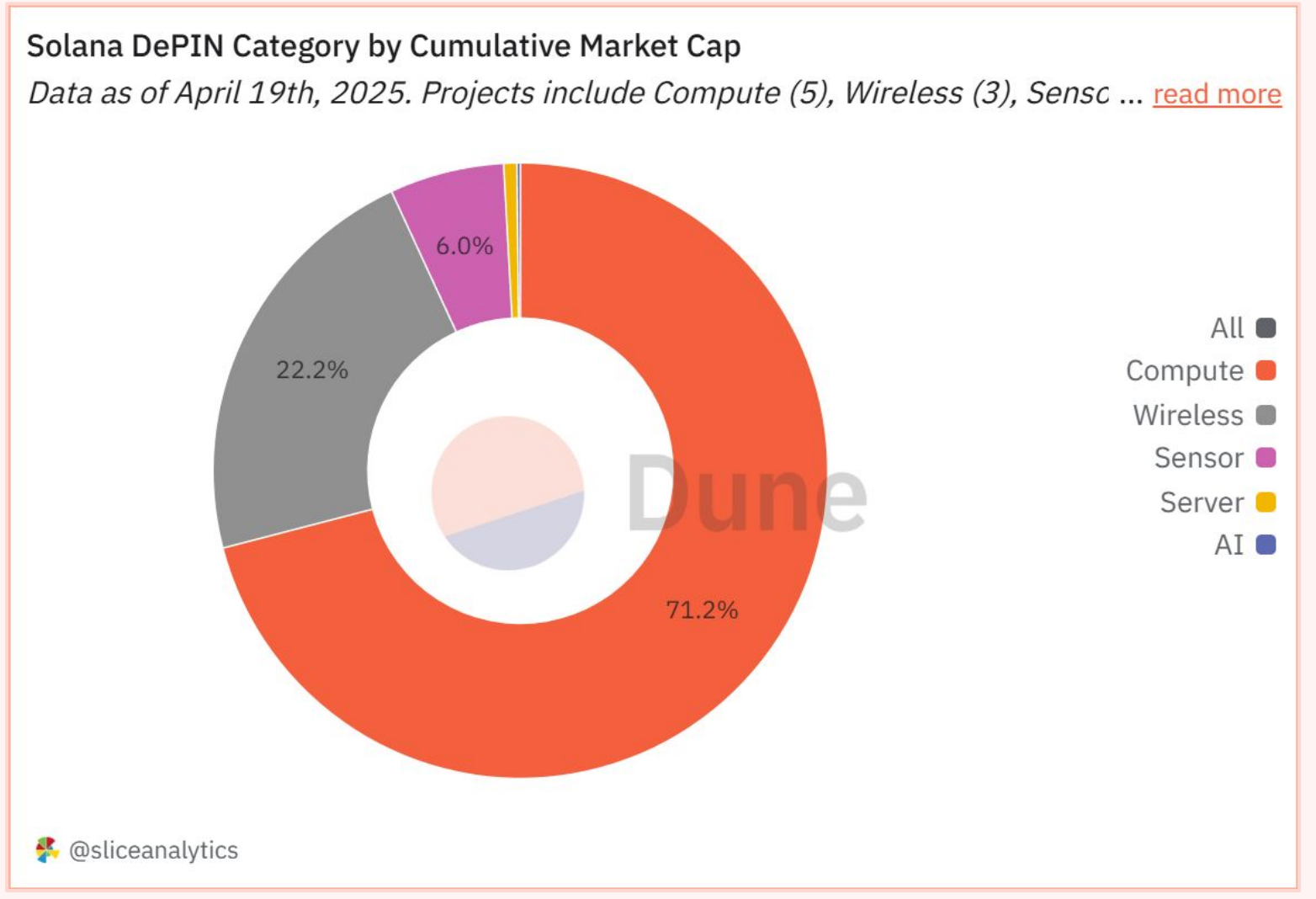
DePIN projects are mainly divided into five categories:
- Compute : accounts for 71.2% of the market share, providing decentralized processing power, GPU and computing infrastructure, such as Render, io.net, Nosana, LooPIN Network, Hivello
- Wireless : accounts for 22.2% of the market share, providing community-driven wireless and mobile access networks, such as Helium, ROAM Token, Helium Mobile
- Sensor : Collect real-world data through distributed sensing devices, such as Hivemapper, Geodnet, WeatherXM, NATIX Network
- Server : Provides distributed cloud and storage servers for hosting or accessing data, such as Shadow Token and ScPrime
- AI: Decentralized networks that support AI data generation, labeling or robotics technology, such as UpRock, Homebrew Robotics Club
The computing and wireless categories together account for 93.4% of the market share, and are also the category with the highest average market value. Computing networks such as Render and io.net provide high-market-value utility tokens for AI workloads, while wireless projects such as Helium and ROAM represent the most mature and widely adopted infrastructure layers.
Node Growth and Network Participation
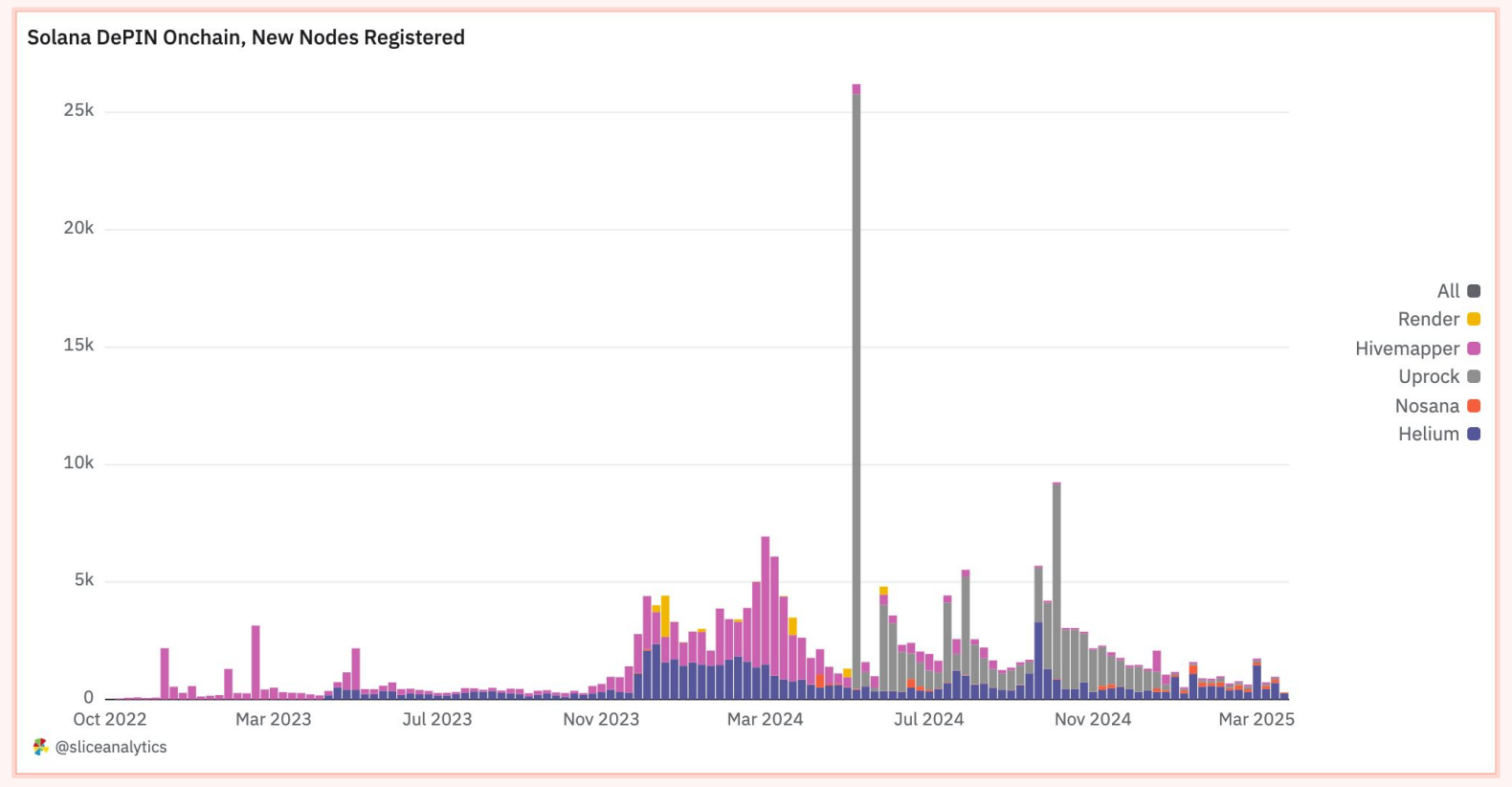
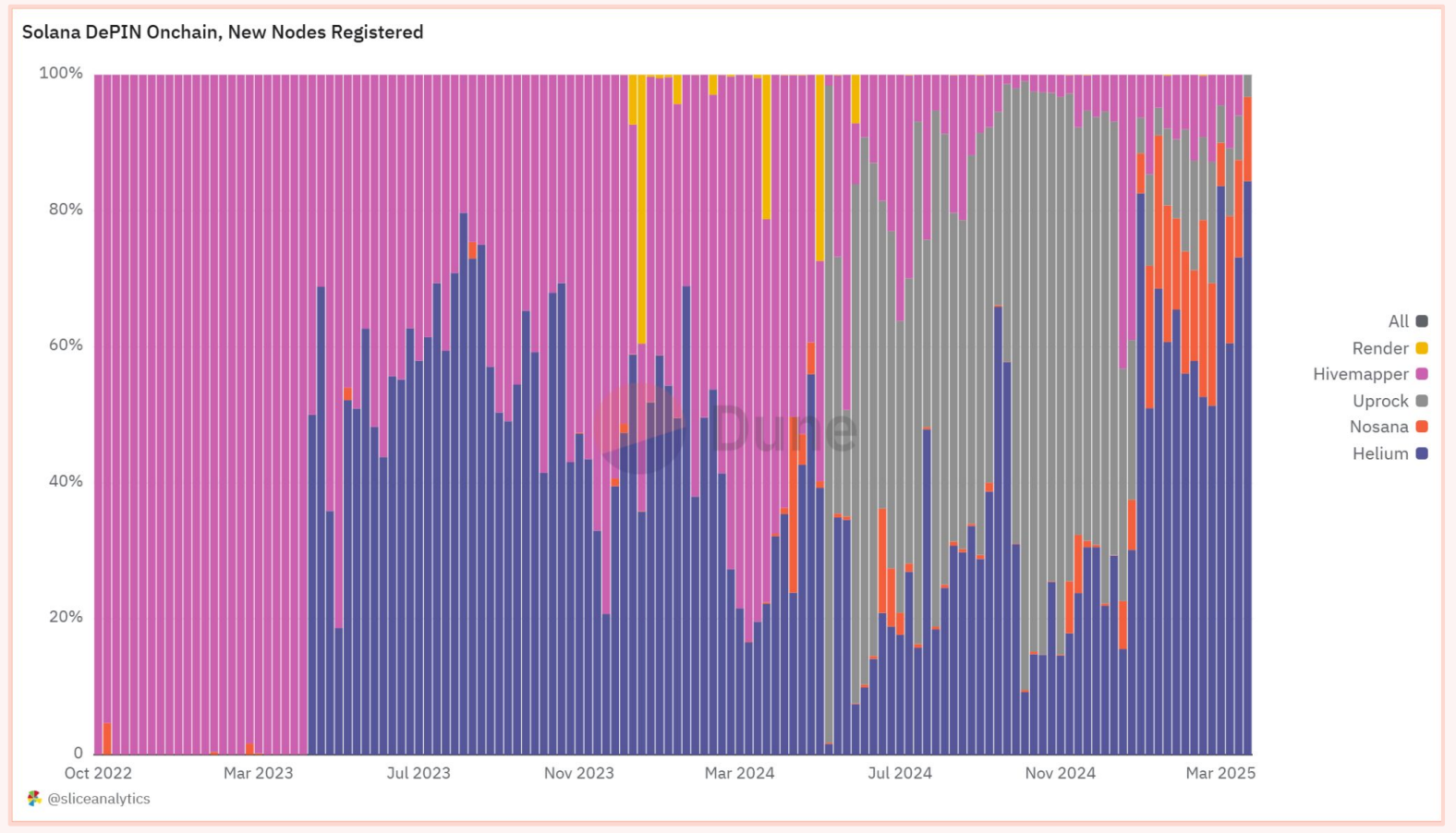
As of April 22, 2025, the total number of registered on-chain nodes for the DePIN project on Solana reached 238,165. A DePIN node is a physical or digital infrastructure unit such as a GPU, an IoT hotspot or a dash recorder that performs critical network functions such as computing, data collection or wireless transmission. The growth in the number of nodes reflects the scale, degree of decentralization and practicality of the network. More nodes usually mean stronger coverage, higher engagement and reliability.
In terms of node growth, the Solana DePIN project has shown significant changes. Hivemapper initially led the way, but Helium quickly surpassed after launching Helium Mobile, now accounting for more than 60% of the new node share. While Render contributes fewer new nodes, it leads in revenue per node. Nosana gained traction in early 2025, while Uprock flattened after rapid growth in late 2024.
On-chain network revenue
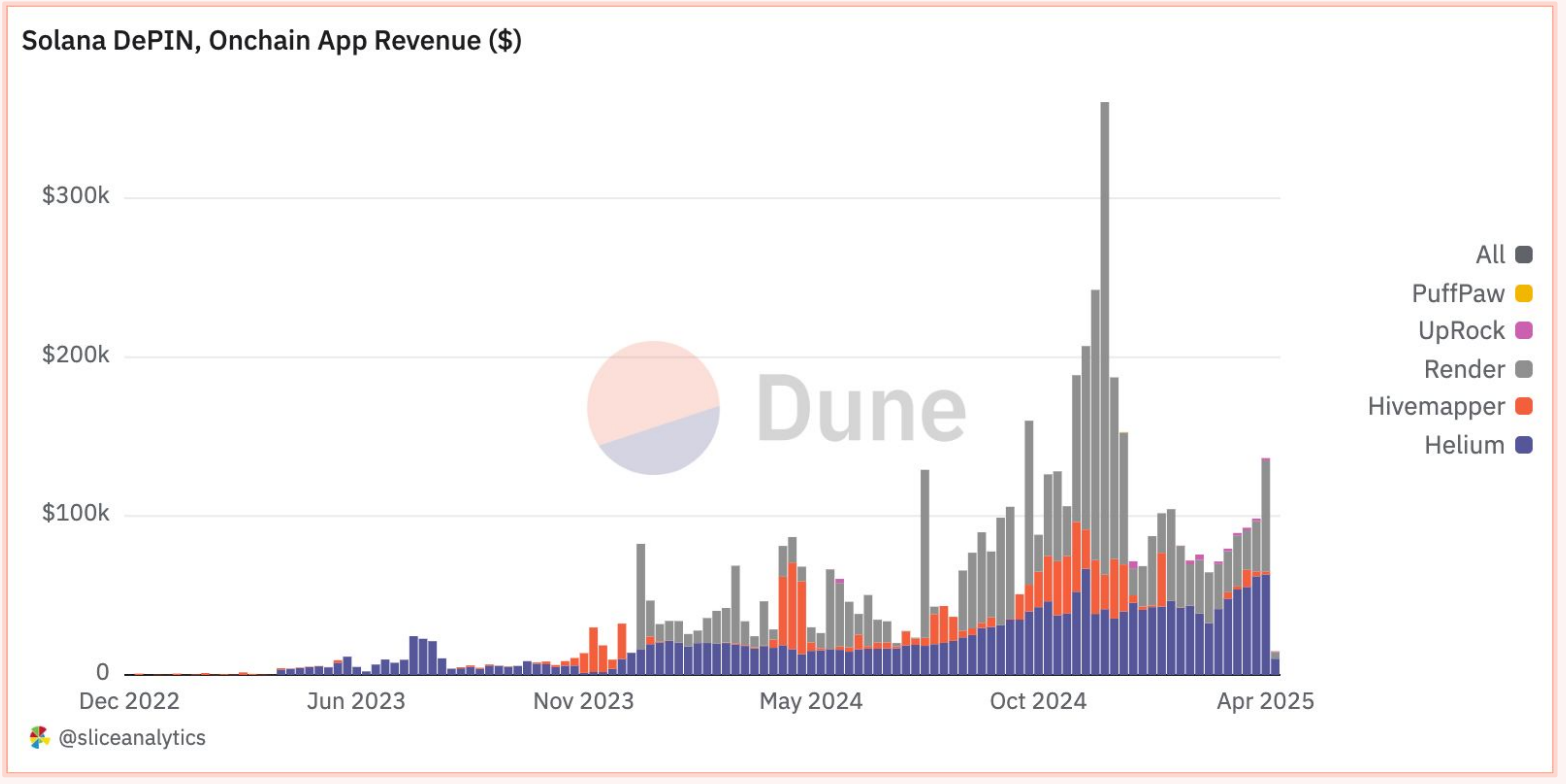
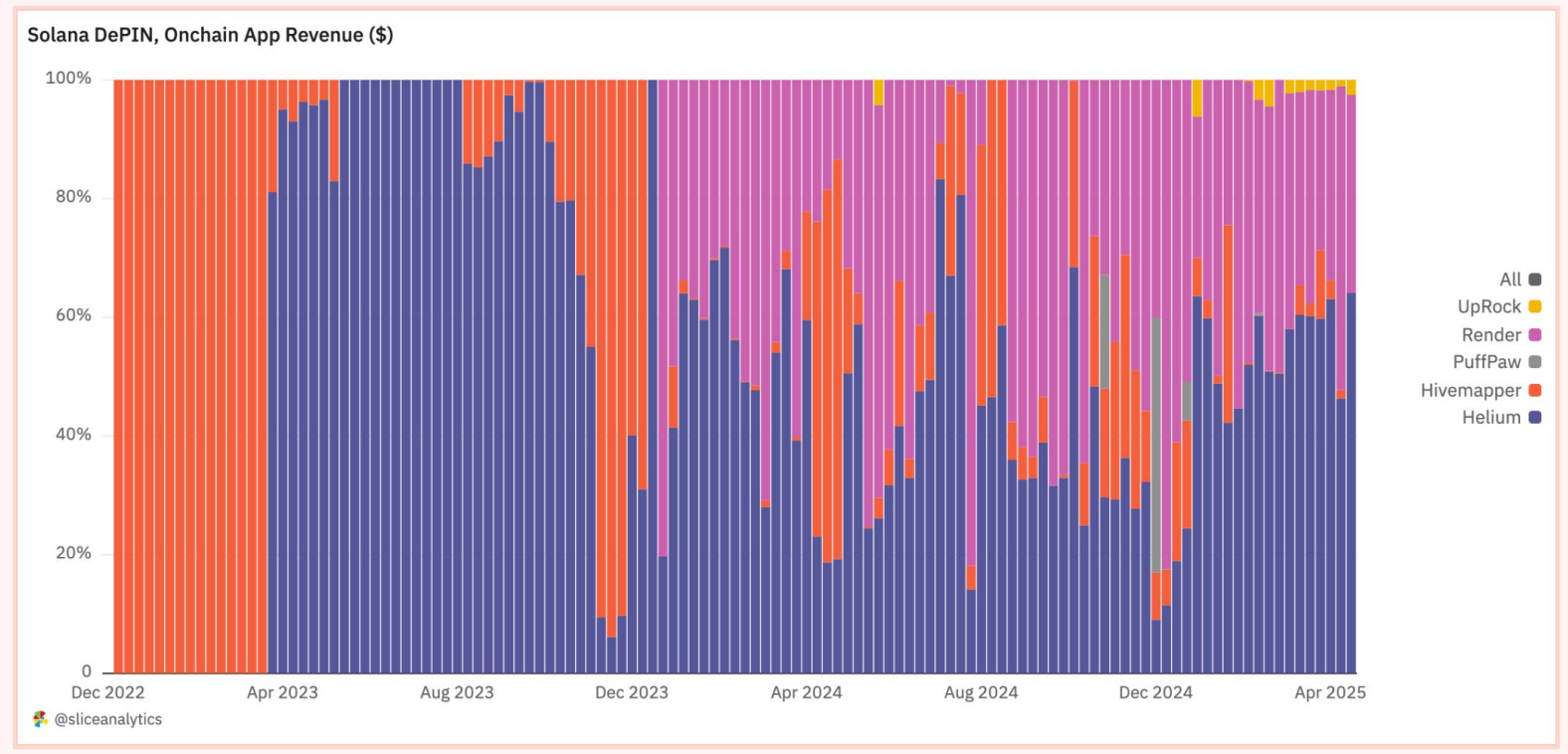
As the cryptocurrency industry matures, on-chain revenue has become a key indicator for evaluating project feasibility, product market fit, and sustainable business models. As of April 22, 2025, the total on-chain revenue of the DePIN project on Solana reached US$5.98 million.
The DePIN project's revenue on Solana has grown steadily, from about $4,000 a week in April 2023 to more than $100,000 a week in early 2025, peaking at $130,000 in mid-April. Helium is the highest earner per week, reaching $60,000 (60% share), while Render leads in total revenue ($2.65 million, compared to Helium’s $2.3 million). Render also maintained a record of $300,000, a single-week peak in revenue set at the end of 2024. These trends highlight the rising adoption rate, with each project gaining traction at different points in the DePIN growth cycle.
Major project analysis
1. Helium: The leader in decentralized wireless networks
Helium is a decentralized wireless network that enables individuals to deploy hotspots and provide low-cost, secure connectivity to IoT and mobile devices. Users receive HNT token rewards by extending coverage and routing data.
Important milestones:
- 2013: Helium was founded
- 2019: Helium hotspot launches, users begin to get HNT due to coverage
- 2023: Migrate to Solana for increased scalability and speed
- 2024: Publicly released Helium Mobile, a decentralized 5G service
- 2025: Launch Zero Plan, the first free 5G mobile phone package in the United States
- 2025: SEC withdraws lawsuit against Nova Labs, confirming Helium’s token model does not violate securities laws
- 2025: Helium cooperates with AT&T to provide national Wi-Fi coverage
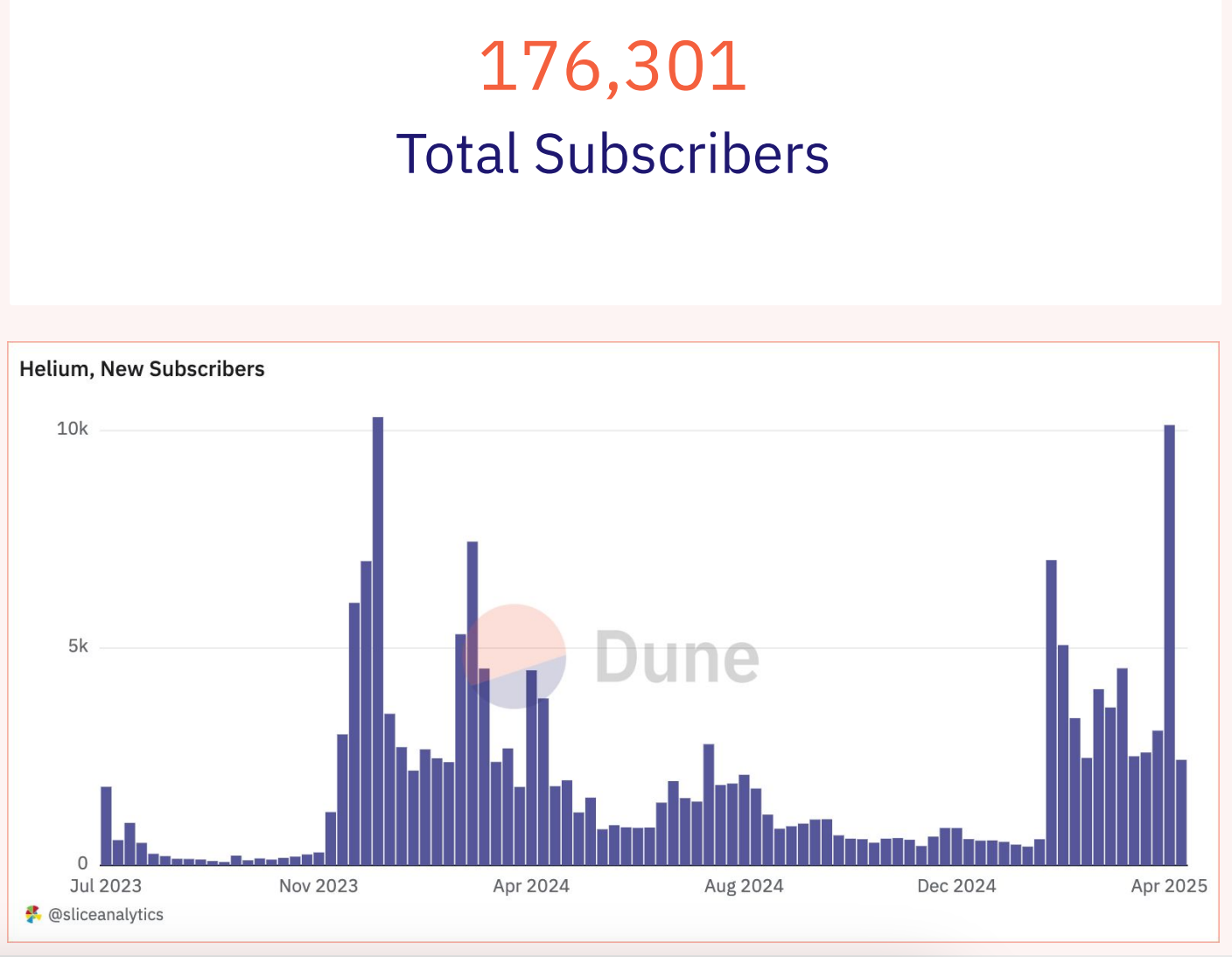
Key data:
- Total subscribers: 176,301
- Total number of nodes: 69,449
- Total on-chain revenue: US$2.29 million
Helium’s subscription user growth is affected by a clear product-driven inflection point. In January 2024, the number of new subscription users reached 10,300 within one week after the official release of Helium Mobile, which promoted the deployment of more hot topics and network expansion. Subsequently, the Zero Plan (the first free 5G mobile phone package in the United States) launched in February 2025, triggering a second wave of growth, quickly filling the waiting list. After the free tier was opened to everyone in April, the number of users once again peaked at 10,000.
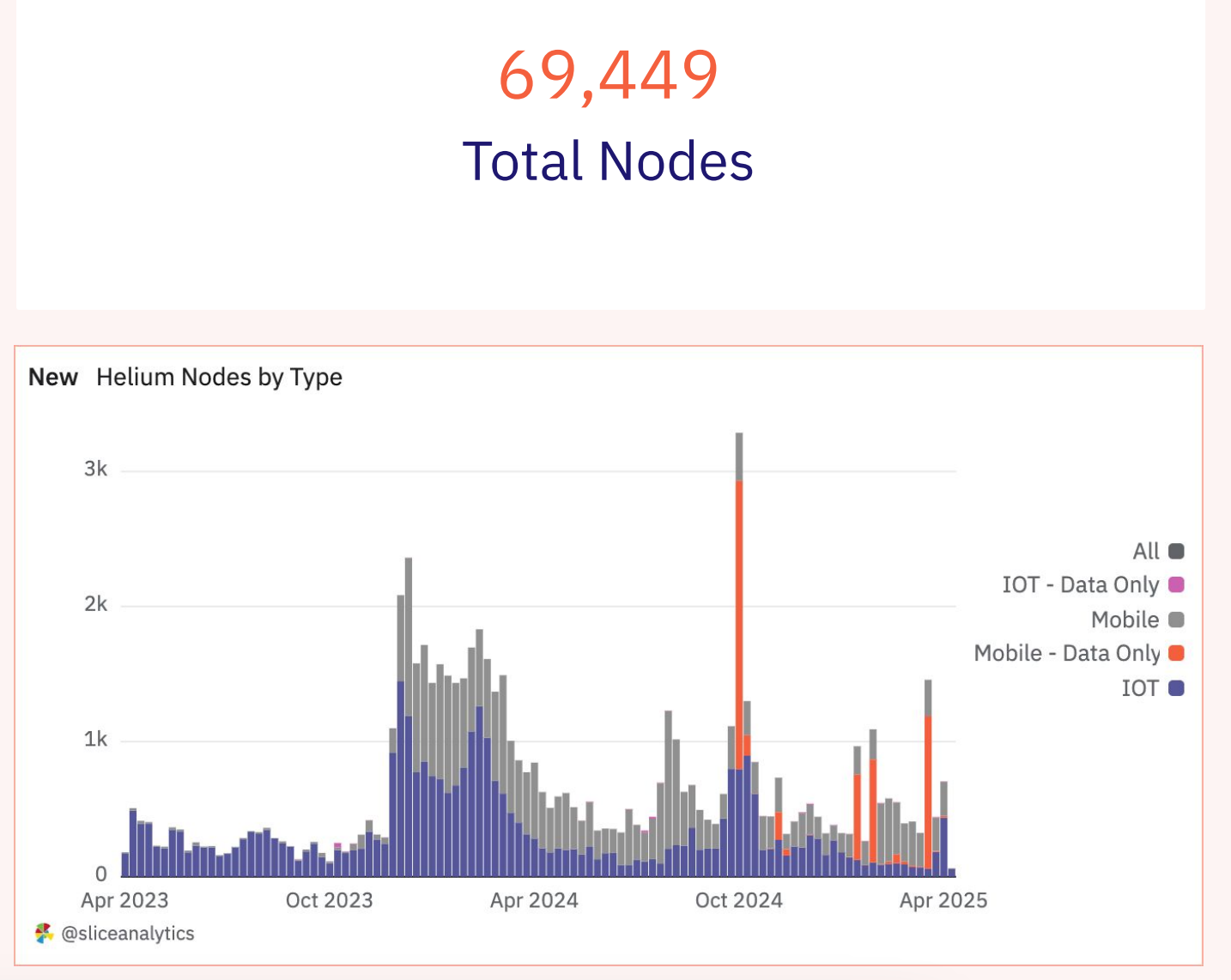
As of the reporting period, Helium's total subscription users had reached 176,301, and the total number of nodes was 69,449. The node composition is showing a changing trend, with mobile data-specific categories growing particularly strongly. The report notes that two major events have driven the peak of node deployment. First, the cooperation with Ameriband in October 2024 added more than 100,000 data-only hotspots to retail and commercial sites in the United States; second, the user growth accelerated again after the cancellation of the Zero Plan waiting list in April 2025.
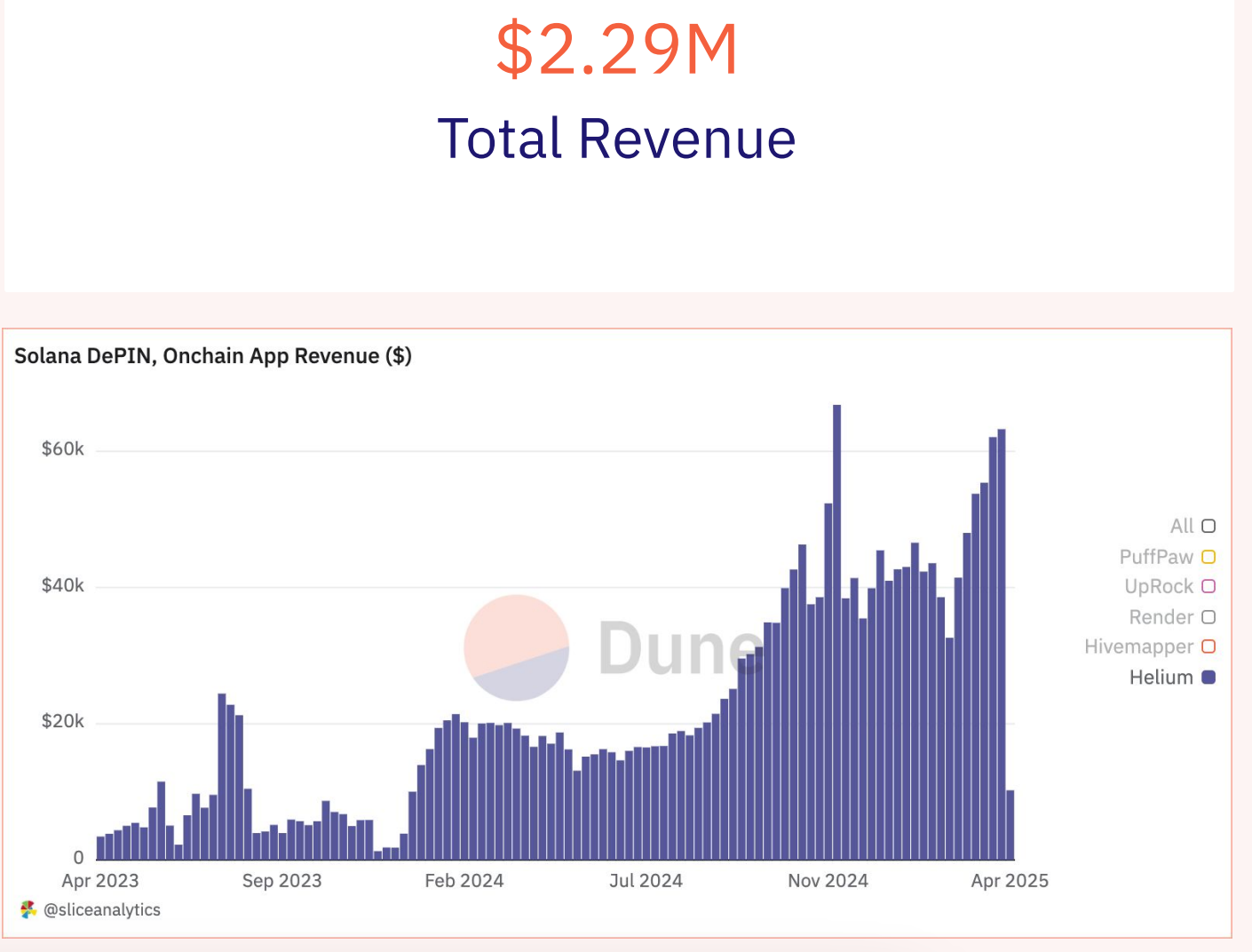
Helium generates on-chain revenue through its unique combustion-casting model, where users can convert HNTs into non-transferable data credits (DCs) for access to services on their IoT and mobile networks. Specifically, mobile data is billed at $0.50 per gigabyte (i.e. 50,000 DCs), while IoT usage is charged at increments per 24-byte message. The company's revenue grew steadily, setting a record of $66,000 per week in December 2024 and again hit a sustained peak of $63,000 per week in April 2025.
2. Hivemapper: Decentralized Map Network
Hivemapper is a decentralized, community-driven map network where users collect street-level images through dash recorders to receive HONEY token rewards. By transforming daily driving into a data source, Hivemapper provides fresher and more dynamic maps for areas such as transportation, logistics and autonomous driving.
Important milestones:
- 2022: Launching Hivemapper Network and HONEY Tokens
- 2023: Network-mapping unique road kilometers exceeds 1 million
- 2024: Launch of Bee dash recorder for high-quality image capture
- 2024: Release Beekeeper, a fleet management tool without SaaS lockdown
- 2025: Bee Maps begins serving major customers such as TomTom, Mapbox and Trimble
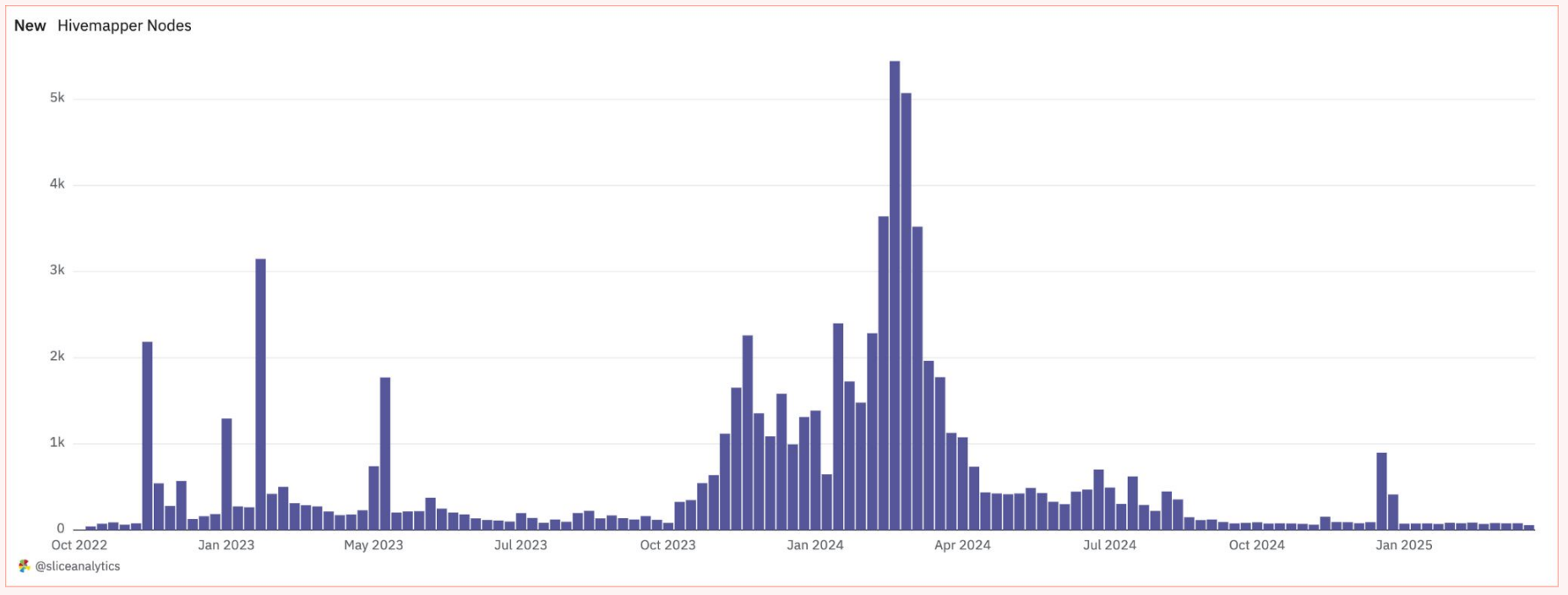
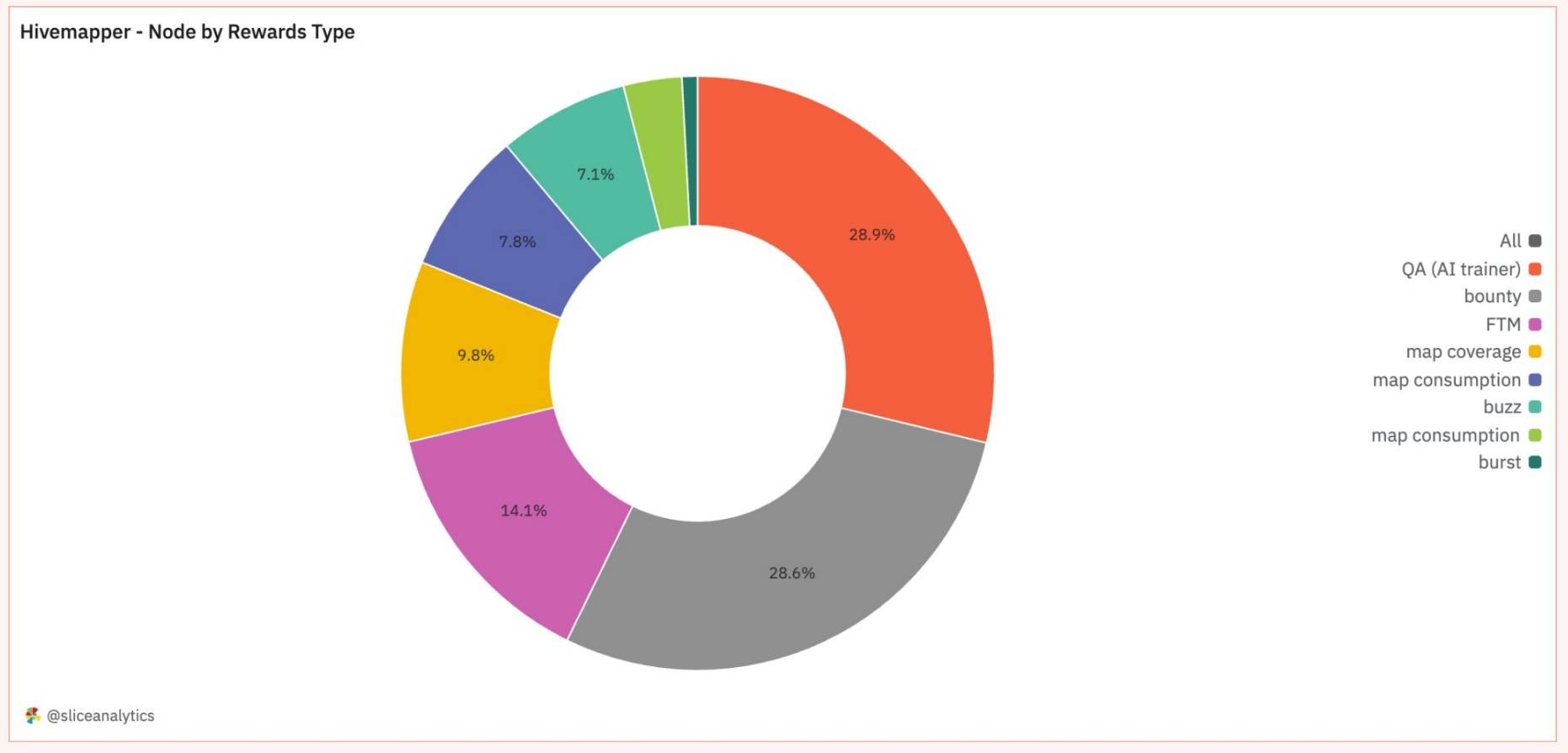
Key data:
- Total number of nodes: 77,483
- Weekly Reward: Over $60,000 HONEY
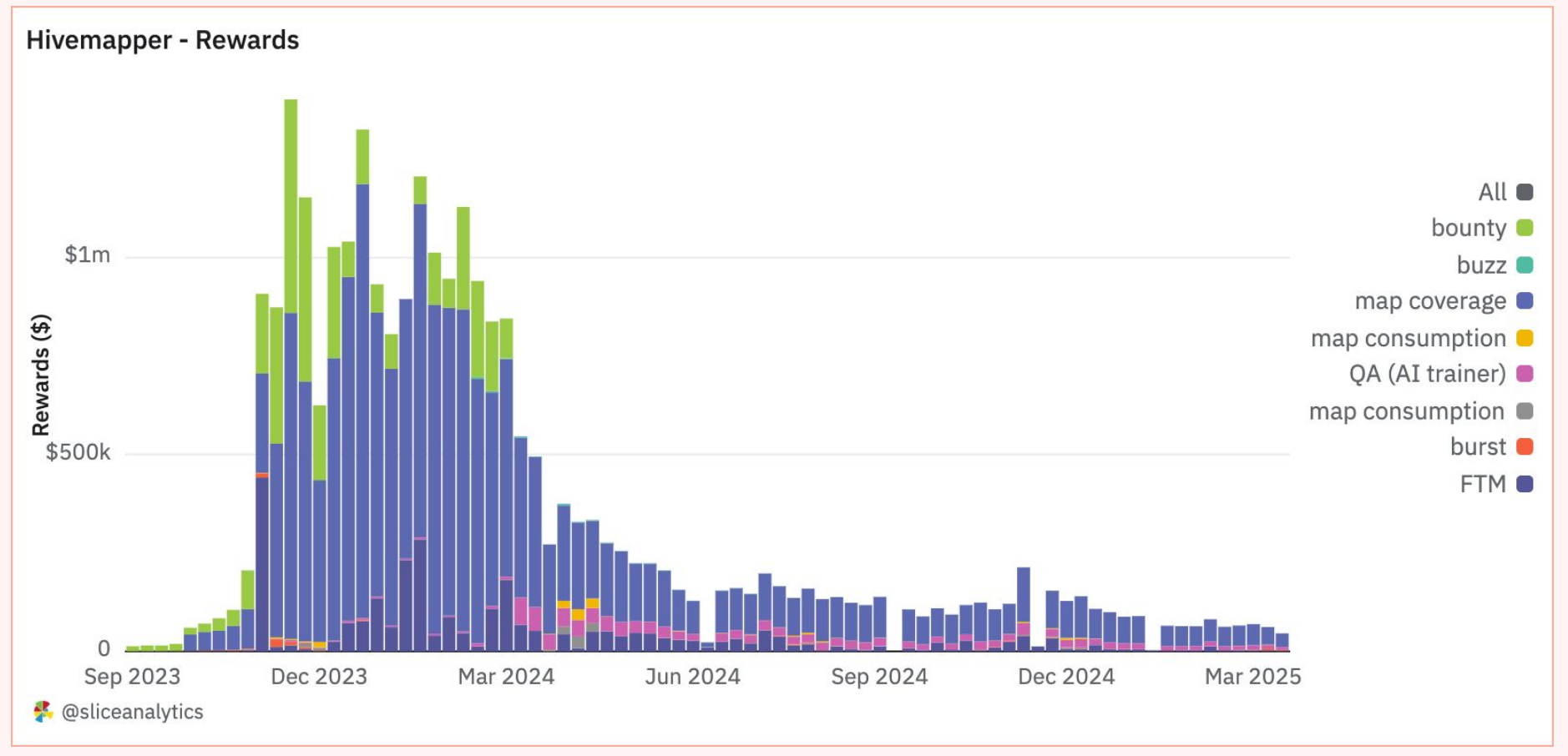
As of April 2025, the network has 77,483 nodes, most of which are active in AI training and reward activities, however less than 10% of nodes are rewarded for map coverage. Despite the decline in Hivemapper’s weekly rewards from its peak of $1.4 million in December 2023, the network still distributes more than $60,000 in HONEY tokens per week. It is worth noting that although less than 10% of nodes actively contribute to map coverage, these nodes always receive about 80% of the total reward.
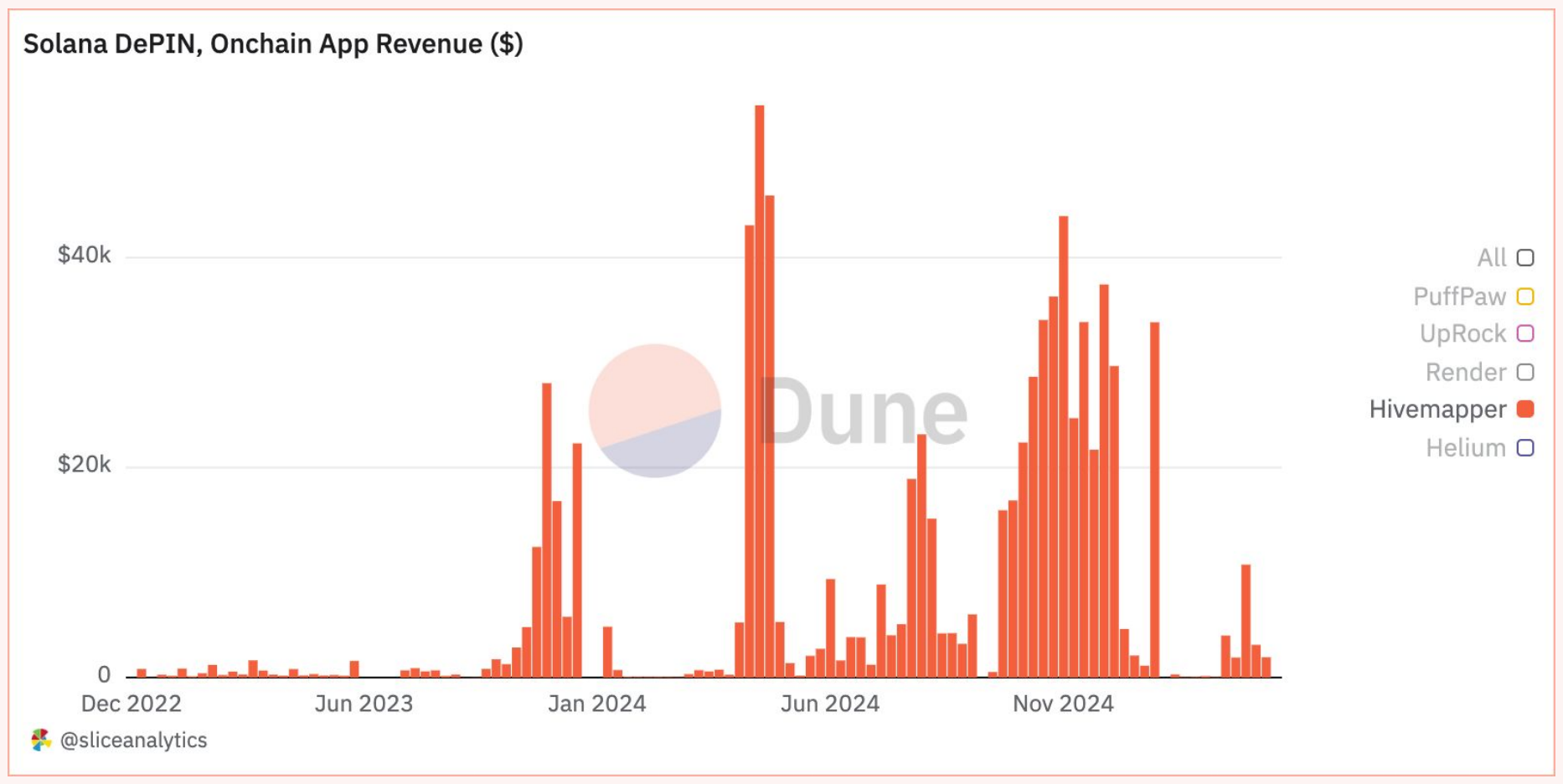
Hivemapper earns revenue by selling Map Credits ($0.005 each), which are purchased by burning HONEY tokens for accessing map data. Income trends show peaking at $30,000 per week by the end of 2023 and exceeding $50,000 per week between April and May 2024.
3. Render: Decentralized GPU rendering network
Render Network is a high-performance distributed GPU rendering network that leverages industry-leading OTOY Inc. software to promote the computing market between GPU providers and requesters. GPU owners can monetize idle GPUs by providing computing power to creators seeking rendering resources. It provides scalable, economical rendering services for 3D graphics, dynamic design and AI workloads.
Important milestones:
- 2021: Render decentralized rendering network launches
- 2023: Migrate to Solana and upgrade tokens to RENDER
- 2024: Integrate OctaneRender for Blender via RNP-017
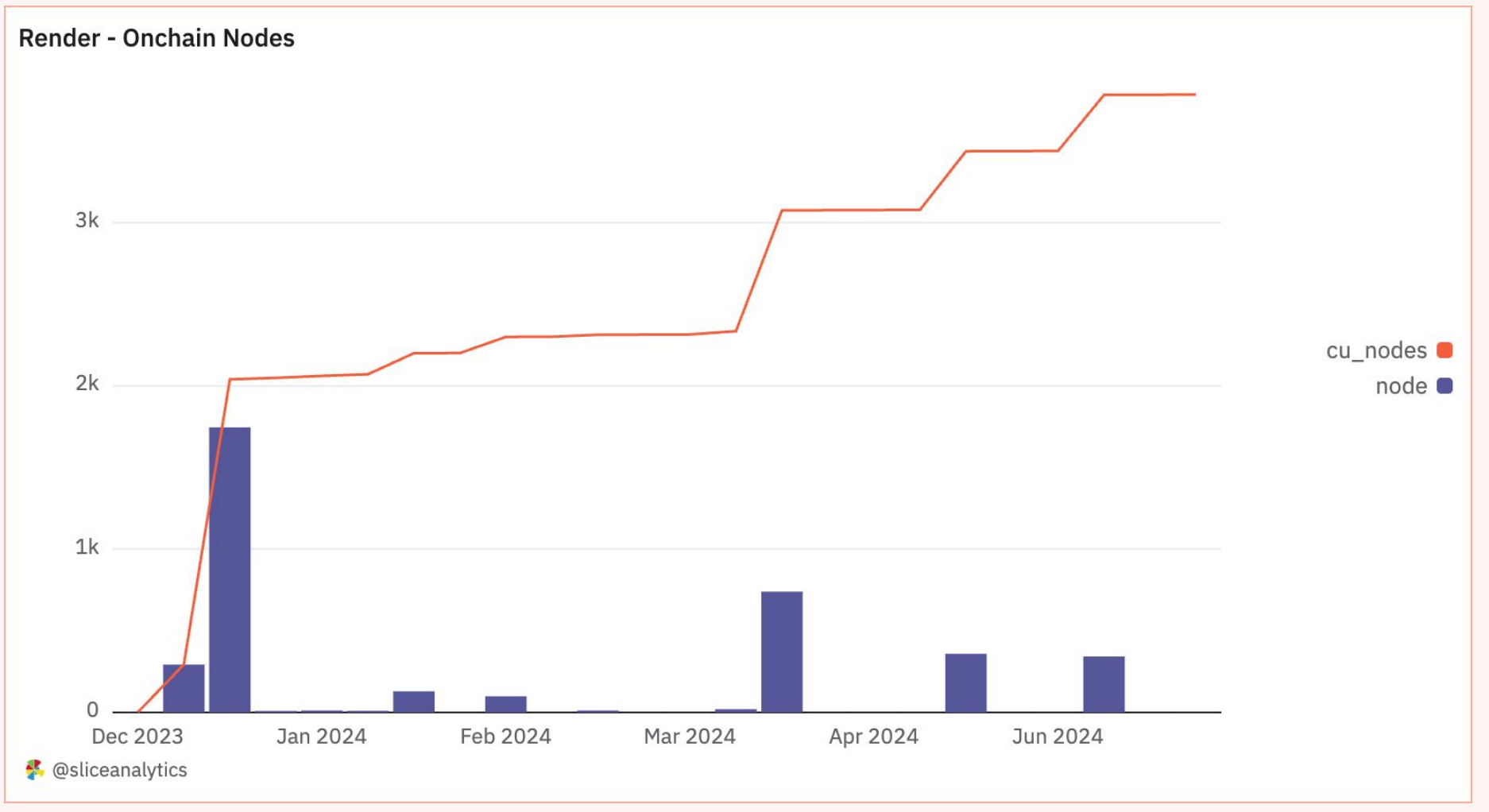
Key data:
- Active chain nodes: 3,784
- Burning RENDER tokens: More than 121 million
- Tokens distributed to node operators: more than 2.4 million
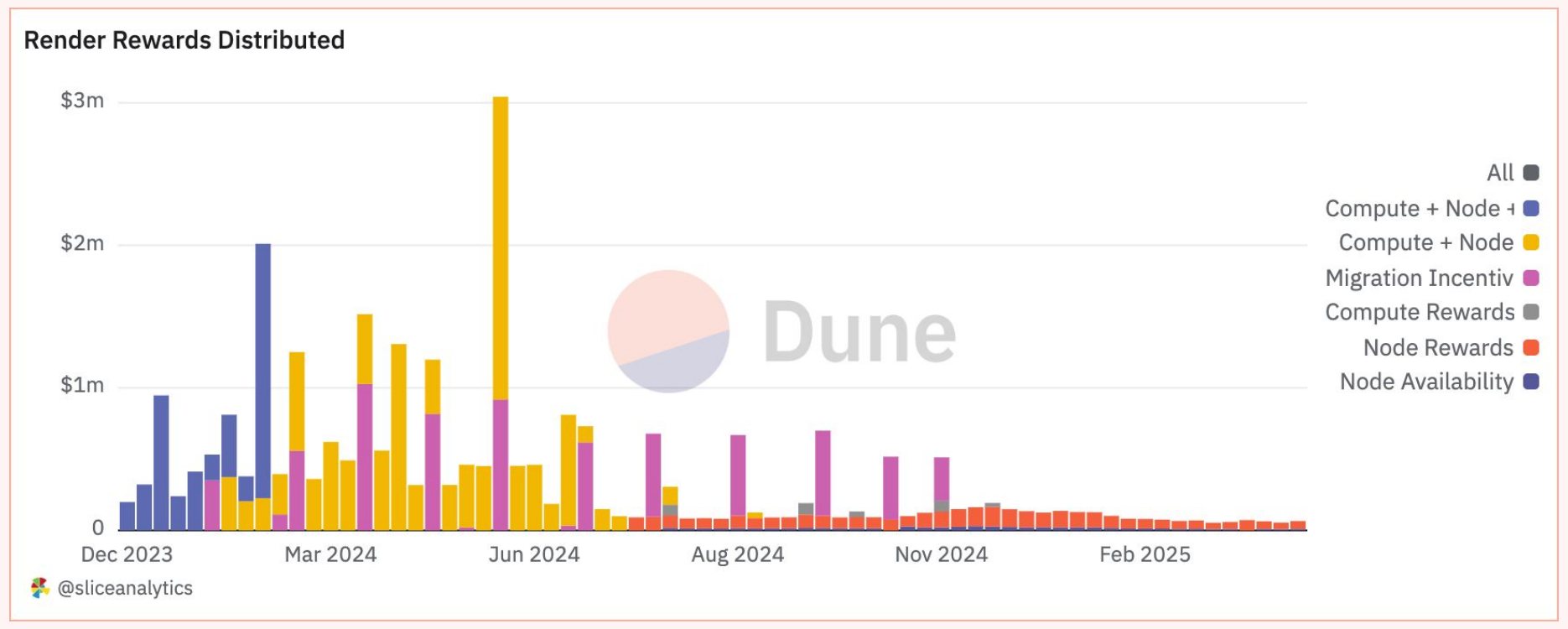
The Render network allows anyone with idle GPU capacity to become a node operator, contributing computing power to decentralized rendering and AI infrastructure. Node operators rent out their GPU capabilities to artists, studios and AI developers who need scalable, on-demand computing, and in return they earn RENDER tokens.
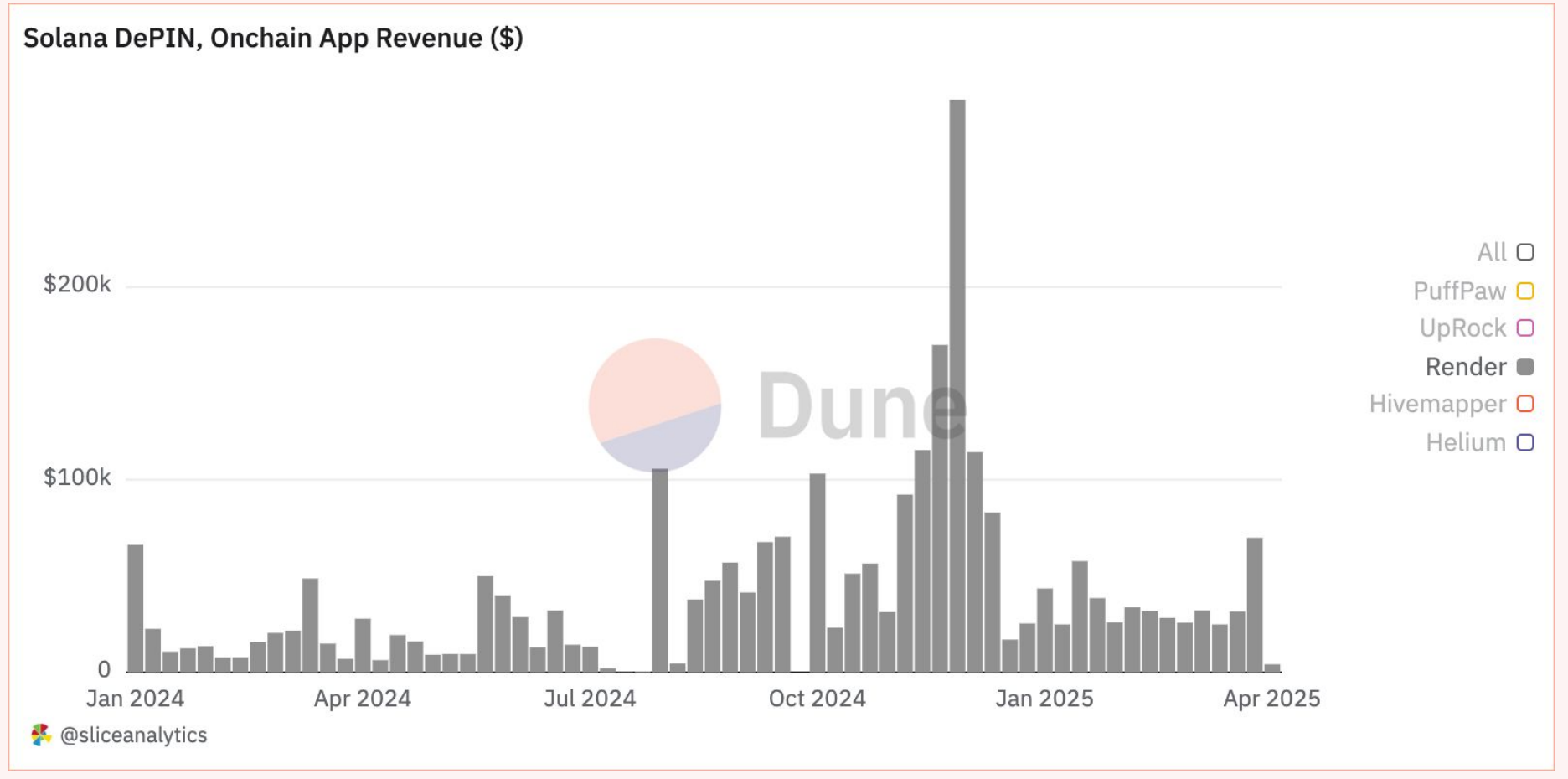
As of April 2025, Render Network has 3,784 active on-chain nodes, providing decentralized computing power to the growing ecosystem of creative and AI applications. To date, the user access to GPU capability has burned more than 121 million RENDER tokens while minting more than 2.4 million tokens to reward node operators, showing healthy demand and active participation of the ecosystem. Previous news showed revenue peaked at nearly $300,000 per week from November to December 2024, thanks to key upgrades (RNP-016 to 018), extended artist incentives and Advent Calendar campaigns with free GPU points and prizes. Another significant peak occurred in mid-April 2025, with weekly revenue reaching $70,000, indicating that creator demand and network adoption are recovering.
4. Nosana: Decentralized AI computing network
Nosana is a decentralized computing network where users can run AI inference tasks through a global GPU host grid. Participants register idle GPUs as nodes and earn $NOS tokens by completing tasks in the network-specific job market. Nosana's solution provides a scalable, censorship-resistant alternative that leverages underutilized GPU resources around the world to provide more cost-effective options for AI computing.
Important milestones:
- 2024: Launch the Global Test Grid
- 2024: Release Node V2, significantly improving performance
- 2025: GPU market owners are online
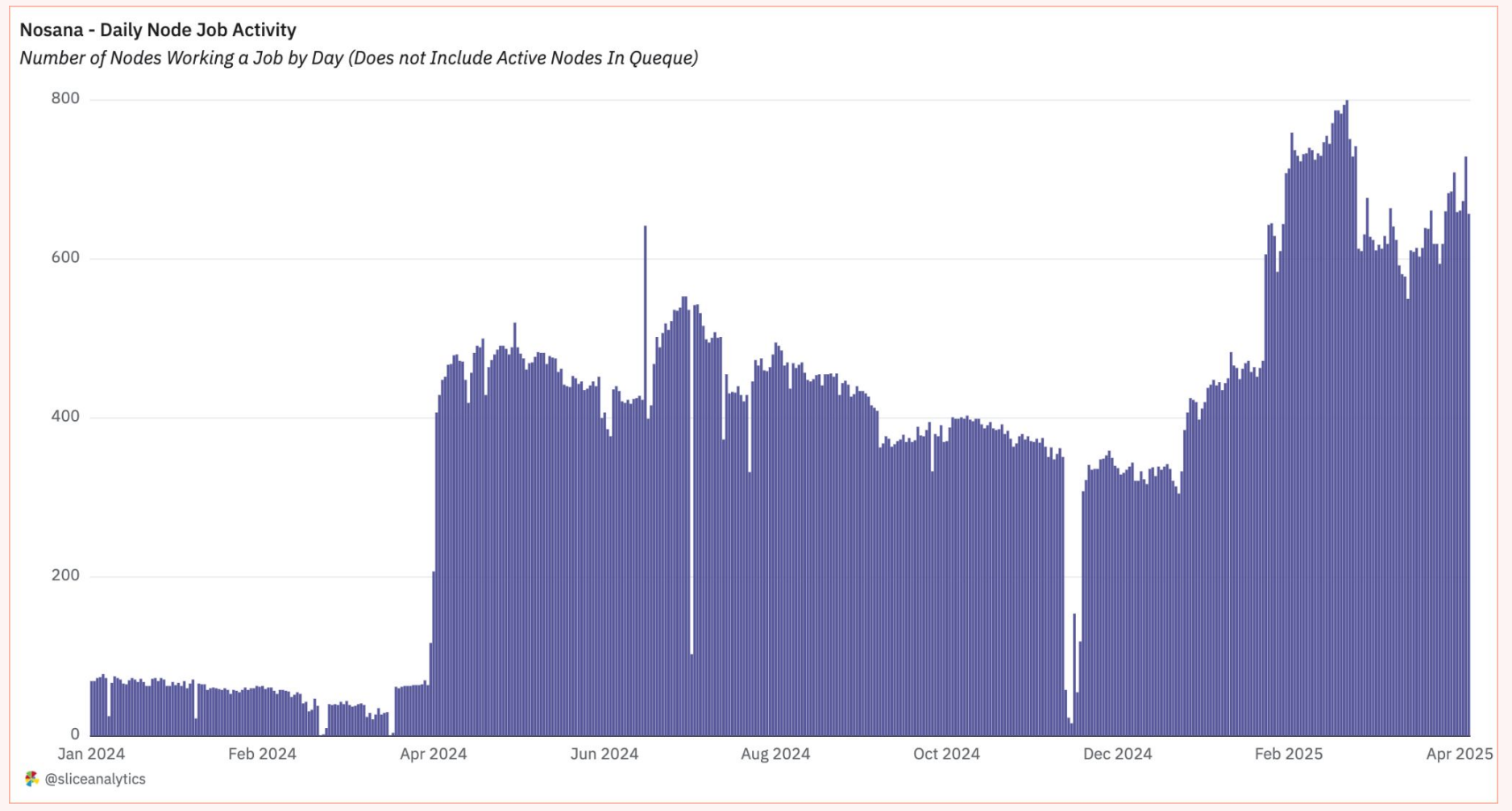
Key data:
- Global node number: more than 4,200
- Daily active nodes: Increased from an average of 300 in 2024 to more than 600 in 2025
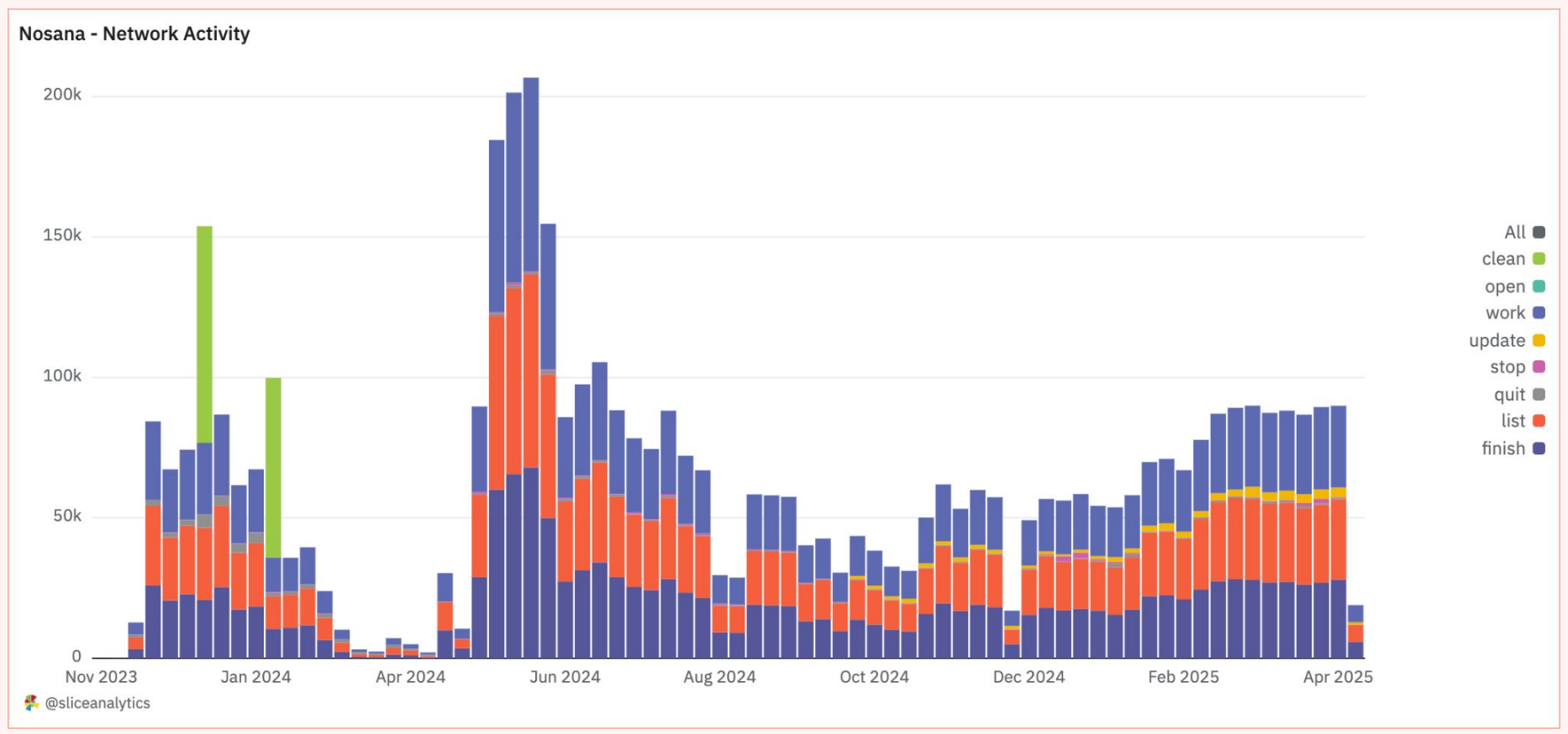
In January 2025, Nosana officially launched its decentralized GPU market to the public. This release, after a year of closed testing, triggered a significant increase in node activity: the number of daily active nodes increased from an average of 300 in 2024 to more than 600, and the peak in March 2025 was over 800. This growth indicates the increasing adoption rate of GPU hosts and AI developers.
With more than 4,200 nodes joining around the world, Nosana demonstrates scalable performance and continuous activity as a powerful decentralized alternative to traditional computing providers. Its on-chain activities are driven by the interaction between the node operator and the work market, reflecting the actual use of its decentralized GPU network. The network reached a historical high of more than 200,000 operations per week in May 2024 and was stable at about 80,000 operations, showing a healthy and continuous demand for computing tasks.
Most activities come from three key command types: creating new jobs, queuing nodes to perform tasks, completing tasks and paying compensation. These three commands represent the core work life cycle on the network and maintain a relatively stable usage pattern. The less common instructions such as stop, exit and cleanup, about 1000 times a week, show lower early task termination or cleanup rates, further demonstrating good alignment of system stability and incentive mechanisms.
5. UpRock: Mobile-first data intelligent network
UpRock is a decentralized data intelligent network powered by the mobile-first DePIN model. Users can share unused internet bandwidth and computing power through the UpRock app, turning everyday devices into passive data contributors, earning $UPT tokens. These resources provide real-time, geo-diversified and censor-resistant data support for AI models.
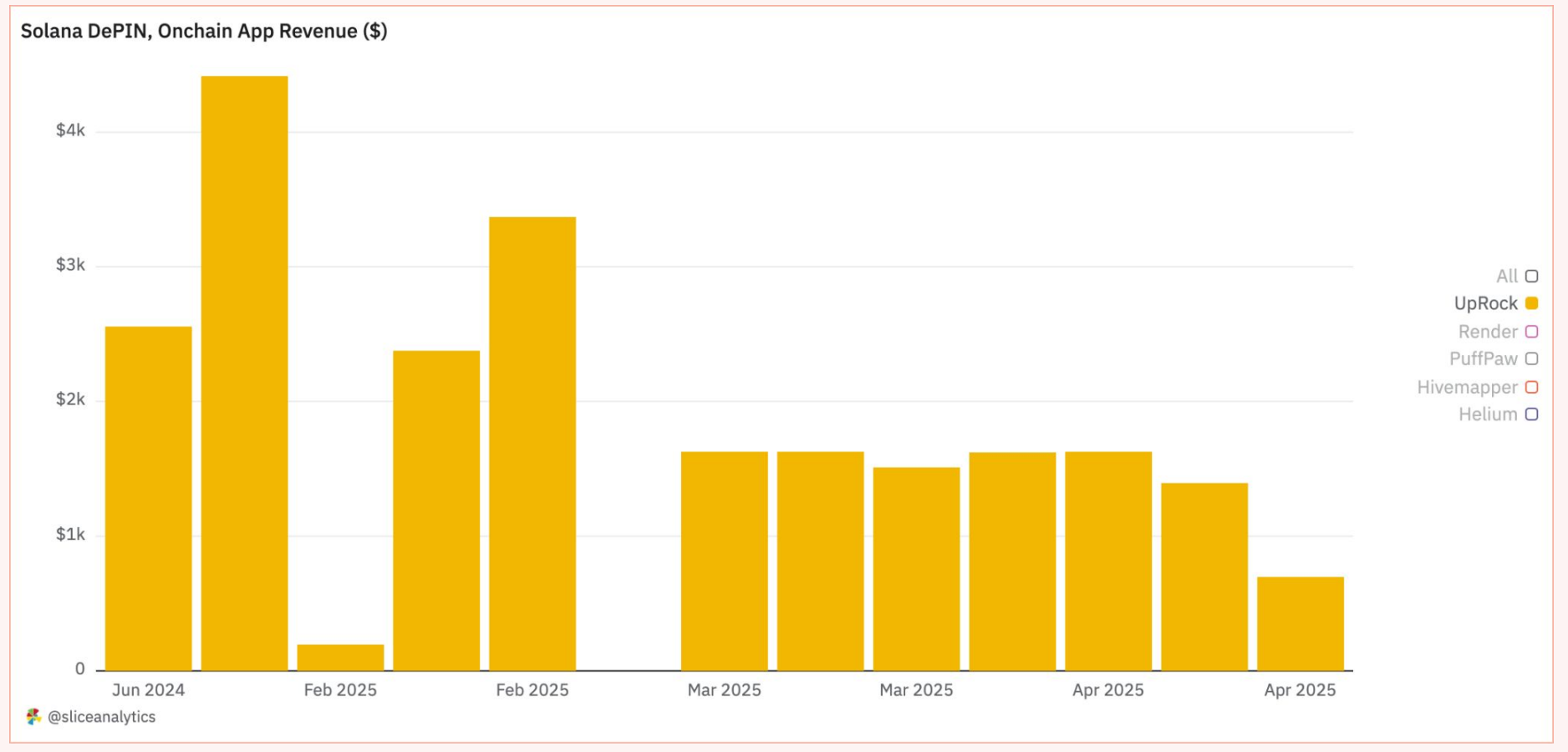
UpRock monetizes through SaaS subscriptions and a paid-per-use API, with some revenues used on-chain $UPT token repurchases, funding contributor rewards and strengthening the ecosystem. After on-chain network revenue peaked at more than $3,000 per week in February 2025, revenue has remained stable at $1,500 per week.
Conclusions and key insights
- Solana 's leadership in the DePIN field : If the agreement chooses not to launch its own independent L1/blockchain, Solana has become the leading chain of DePIN, with a total market value of US$3.25 billion for DePIN projects and an average market value of US$191.3 million for each project.
- On-chain activities prove the actual value of DePIN : DePIN is more than just a narrative. Projects such as Helium, Render and Hivemapper have generated nearly $6 million in on-chain network revenue, which is a strong signal of real product market compatibility.
- Computing and Wireless categories dominate the market : Computing (71.2%) and Wireless (22.2%) categories lead market share in Solana DePIN (total 93.4%).
- Node growth and service adoption accelerated : Helium has more than 176,000 mobile users and 69,000 nodes, while Hivemapper and Render continue to expand their contributor base. Nosana doubles the number of active nodes after the mainnet is started.
- Transparency challenges remain : Despite practical applications, DePIN remains one of the hardest areas of encryption to track on-chain activity, as it relies on off-chain hardware and third-party integration. While progress has been made, fully transparent and consistent on-chain measurements are still in progress.

